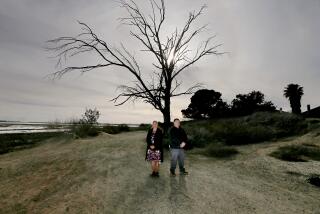Richard Daugherty dies at 91; archaeologist studied Makah tribe site
Tidal erosion caused by a February 1970 winter storm ate away a bank of soil on Washington’s Olympic Peninsula, revealing parts of five Native American longhouses. The longhouses near Lake Ozette had been buried suddenly by a mudslide sometime around 1560, preserving their contents in such remarkable condition that the site is often referred to as the American Pompeii.
Archaeologist Richard Daugherty of Washington State University had previously conducted some minor excavations at the Ozette site, but the revelation of the longhouses provided an unprecedented opportunity to learn more about the culture of the Makah civilization.
Daugherty was known for his pioneering archaeological interaction with the Native Americans, enlisting them to help excavate the site, identify artifacts and explain Makah cultural traditions, many of which had been carried down from the time of the burial. His work served as a template for future interactions between scientists and indigenous peoples.
In the course of 11 years of excavation, Daugherty’s team recovered more than 55,000 artifacts, about 60% of them wooden items that had been exceptionally well preserved by the anaerobic environment produced by the mud.
Ozette became the largest, most complex archaeological site in the Pacific Northwest, according to Washington State University. Many of the artifacts excavated by Daugherty are on display at the Makah Cultural and Research Center in Neah Bay, Wash.
Daugherty died from bone cancer in Pullman, Wash., on Feb. 22, the university said in a news release. He was 91.
“He really set the path for archaeologists and Native Americans to work together instead of in opposition,” said Allyson Brooks, Washington state historic preservation officer. “That’s a big deal.”
Many archaeologists now believe that the Americas were populated by Asians who crossed the Bering land bridge more than 12,000 years ago or came in boats across the relatively short waterway from eastern Russia. Daugherty’s work not only supported such conclusions, but also gave valuable insights into how those early immigrants lived.
The Ozette site was continuously occupied for at least 2,000 years — until the 1920s, when the government forced the remaining residents 20 miles inland for better access to schools. The oxygen-free environment created by wet clay preserved artifacts from the entire period, including arrow shafts, canoe paddles, bows, harpoon shafts, baskets, looms and cedar rope.
The Makah were prolific whalers, but excavation of middens — trash pits — revealed that they also ate fur seal, sea lion, halibut, waterfowl and various berries. Some researchers had also thought that the Makah migrated to offshore islands in the summer for better hunting, but Daugherty concluded that they had too many possessions to make such moves feasible.
He also played a big role in the 1960s excavation of the Marmes rock shelter near the confluence of the Snake and Palouse Rivers in southeastern Washington. Finds included tools and animal and human bones. That site was flooded in February 1969, when the Lower Monumental Dam on the Snake River was completed and a levee built around the site failed.
The Marmes site also revealed human bones which, at 12,000 years old, were then thought to be the remains of North America’s oldest known inhabitants.
In 1977, Daugherty, with co-investigator Carl Gustafson, made another discovery that turned the clock back yet again on human history in the New World. At a site near Sequim, Wash., they identified a hand-made projectile point in a mastodon bone that was dated at 13,800 years old.
It was one of a number of discoveries challenging the long-held theory that the Clovis peoples — named for stone points found near Clovis, N.M. — were the first migrants to the Americas.
During the 1960s, Daugherty worked with powerful Washington senators Warren G. Magnuson and Henry M. “Scoop” Jackson to enact the National Historic Preservation Act. That act created the National Register of Historic Places and mandated that future government projects investigate the archaeological history of a site before construction begins.
Richard Deo Daugherty was born in Aberdeen, Wash. on March 31, 1922. He attended the University of Washington until 1943, when he spent three years in the Navy piloting blimps on the East Coast in search of submarines.
In 1946, he returned to his studies, receiving his bachelor’s degree in anthropology and, in 1954, his doctorate. He joined Washington State University in 1950 and remained there for the rest of his career, retiring in 1983 to become a professor emeritus. After his retirement, he was a consultant on a wide variety of archaeological investigations of construction sites throughout the world.
Daugherty was preceded in death by his first wife, Phyllis. In 2007, he married his long-time collaborator, science writer Ruth Kirk. The couple were married in a replica longhouse at Neah Bay in a ceremony attended by many Makah elders.
In addition to his wife, Daugherty is survived by two daughters, Melinda and Carol; a son, Rick; five grandchildren; and six great-grandchildren.
More to Read
Start your day right
Sign up for Essential California for the L.A. Times biggest news, features and recommendations in your inbox six days a week.
You may occasionally receive promotional content from the Los Angeles Times.






